As we can see, the facility is totally enclosed with controlled access via coded doorways. Before arriving, one is requested to come with freshly laundered clothes, and to not have worked in the garden or on the farm.
Hazorea Aquatics is the largest exporter of Koi, goldfish (comets and shubunkins) and water lilies in Israel. Hazorea Aquatics hopes to double its Koi export within 2 years. In October 2007 a group of pond hobbyists received a tour of the facility. This page describes that tour. This tour is similar to the Kloubec Koi Farm tour that took place in July 2006 in Iowa by similar pond hobbyists.
The Israeli and Japanese method of raising Koi is quite different. The Japanese breeder concentrates on one or two varieties and excels in these varieties - achieving a very high level of fish. These are the fish that are usually entered in competitions. The Japanese exporter will usually represent a number of breeders - each contributing one or two varieties. Hazorea Aquatics concentrates on the mix and not on the individual varieties. Their market is not the one selling 3 year old champion Koi and most of what they do sell is less than one year old and between 5 cm (2 in) and 30 cm (12 in) in size.
Another interesting fact and quite the opposite of what many people think - Israeli and Japanese Koi breeders are not in direct competition with each other but actually complement each other. People who start by buying Israeli Koi often graduate to more expensive Japanese Koi and people who yearn to have Japanese Koi but cannot afford them, buy Israeli Koi. Japanese Koi exports jumped quite significantly when Israeli Koi entered the market and the growth of sales of Japanese Koi has a positive effect on sales of Israeli Koi.
Another difference between Japanese and Israeli Koi is the coloration. Japanese breeders rely heavily on color enhancement through special food, clay etc. while in Israel coloration is ignored. Japanese Koi are usually sold after they have completed a special "finishing course" where they are fed special color enhancing food. Most grades of regular Israeli Koi are taken straight out of the growing tanks and shipped after only the usual pre-shipment starvation. This is probably why many Japanese Koi will loose color or fade without high quality special food while most Israeli Koi will retain their color with regular food.
The first area we toured was the Koi facility. Hazorea Aquatics has pioneered a system
known as
Biosecure Koi,
in order to combat the Koi Herpes Virus (KHV). KHV is a highly contagious disease that usually causes
death to about 80% of all Koi in a pond within 2 weeks and only targets Koi and carp (not goldfish).
Koi seem most susceptible at water temperatures of 72-81°F (22-27°C), but the full range of temperature is
64°F to 81°F (18-27°C). Koi will not get KHV at below 64°F or above 81°F.
External symptoms would be lesions and blisters, bleeding gills and sunken eyes. There is no treatment for KHV -
once your fish has it - it will either live or die.
As we can see, the facility is totally enclosed with controlled access via coded doorways. Before
arriving, one is requested to come with freshly laundered clothes, and to not have worked in the garden
or on the farm.
Immediately after entering the doorway, one is requested to change their shoes and to step onto the special
wet mat to clear the bottom of the shoes. In addition, one is requested to wash their hands and then re-wash them with
alcohol.
First we viewed the Koi spawning tanks.
 What you see here is an overview of the growing facility.
Their growing system has about 1500 cu. m. (about 400 thousand US gallons)
of water in it. It is divided into 4 separate systems - each with a
Hydrotech
drum filter for solids, a
Hanovia
UV filter and a self
constructed trickle tower. The water is circulated a few times per hour.
The systems for larval and initial growth are much smaller but built
along the same lines.
What you see here is an overview of the growing facility.
Their growing system has about 1500 cu. m. (about 400 thousand US gallons)
of water in it. It is divided into 4 separate systems - each with a
Hydrotech
drum filter for solids, a
Hanovia
UV filter and a self
constructed trickle tower. The water is circulated a few times per hour.
The systems for larval and initial growth are much smaller but built
along the same lines.
Now we arrive at the dozens on tanks that have various sized Koi. What you see above is a tank with
hundreds of 3cm sized Koi.
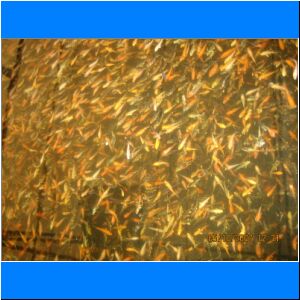 5cm-tank.JPG |
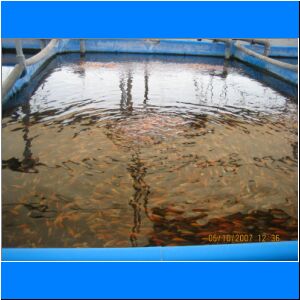 5cm-tank-2.JPG |
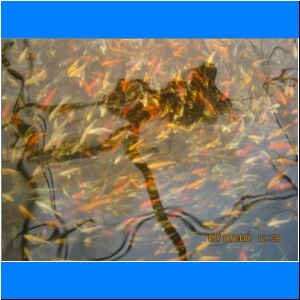 8cm-tank.JPG |
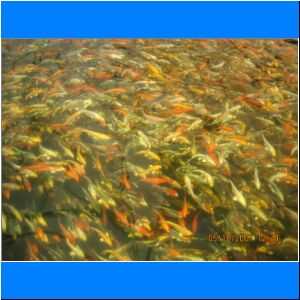 8cm-tank-2.JPG |
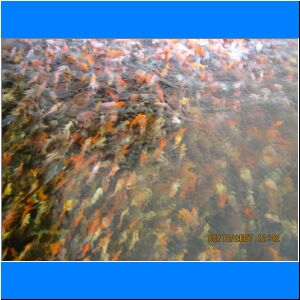 8cm-tank-3.JPG |
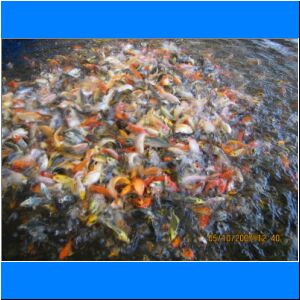 8cm-tank-feeding.JPG |
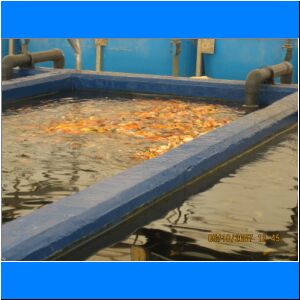 8cm-tank-feeding-2.JPG |
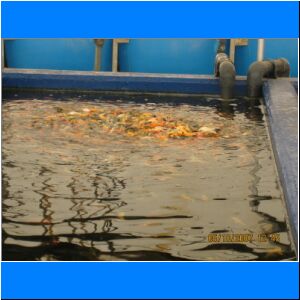 8cm-tank-feeding-3.JPG |
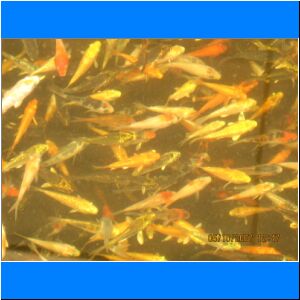 12cm-tank.JPG |
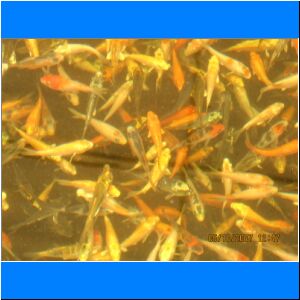 12cm-tank-2.JPG |
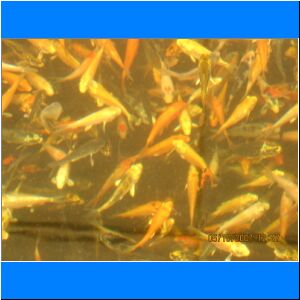 12cm-tank-3.JPG |
Finally we arrive at the 30-40cm Koi tank, with fish that have been raised for 2 years. The previous 5 pictures
show the various large Koi in their tanks.
We now leave the bio-secure area.
We left the bio-secure area and went outside to the holding tanks for the various "fancy" goldfish such as
shubunkins and comets. These fish are grown in outdoor ponds and then brought to these holding tanks before
packing and shipping.
Once the fish have been categorized they are shipped. Hazorea Aquatics uses heavy cardboard boxes with a
double plastic bag. Each box will contain 15 liters of water and oxygen is added along with numerous fish.
The fish are cooled down before packing so as to slow their metabolism. The fish
are flown to their destinations and usually arrive within 18 hours of packing. Since most flights out of Israel
to the US (as well as to Europe and the Far East) depart between 11pm and 1am,
the fish are packed in the evening and taken straight to the cargo hold
of the airplane and are kept in that cargo hold at a certain temperature.
Lastly, we visited their 250 water lily ponds where they grow various hardy and tropical water lilies.
They export just the
rhizome.
This tour was made possible by
Danny Benjamin,
Director of Marketing and Sales at Hazorea Aquatics.